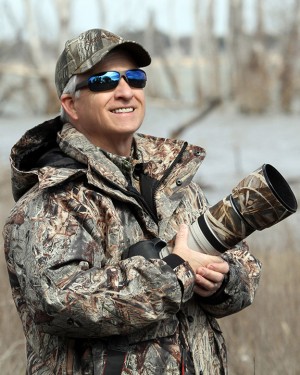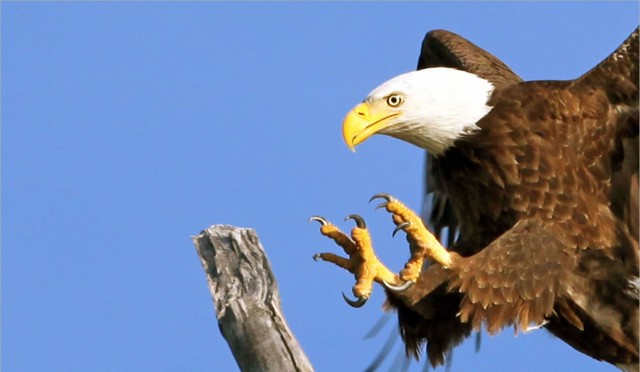
Photos courtesy of Brian Boyd
Staff Writer
The Lake Waco area is home to southern bald eagles, and the community is working to construct a 50-foot nesting tower to ensure that the eagles always have a place to inhabit in the area.
Janet Wallace, president of the Central Texas Audubon Society, said 20 years ago bald eagles were discovered nesting near the shores of Lake Waco. The Audubon Society is concerned, Wallace said, because the eagles have been selecting dead cottonwood trees to build their nests in.
“For two years, the eagle nests blew down, and one year the eaglets drowned, and the other year they died when they fell out of their nest,” Wallace said. “So we decided to start trying to figure out a way to put up something that would be permanent to hold the nest and be away from the water, and would be in spot that would be where they normally come to nest.”
Several organizations have partnered together to support building a tower that will support a sturdy nesting site.
The Central Texas Audubon Society, Cameron Park Zoo, the U.S. Army Corps of Engineers and other donors have gathered funds for the tower, Wallace said.
The tower will be built at the location of the eagles’ first nest, where old nesting material still exists. It will be 50 feet tall and made of concrete and will contain a large basket made of steel, as nests can be as much as 5 feet across, Wallace said, and even larger as eagles add nesting materials. The tower will be engineered to withstand heavy winds, she said, so the nest won’t blow down.
“In other states that have used this, the eagles have used the towers,” Wallace said. “If it’s there and it’s been there for a little while, and they’re coming back, and they’re looking for a nesting place, then they will most likely choose it, especially since it’s in a place where they’ve nested before — or at least, that’s what we’re hoping.”
The Audubon Society has paid $7,000 to purchase the tower, and the U.S. Army Corps of Engineers has agreed to match the amount for things such as signage and blinds, which are stations photographers can use to photograph the eagles safely without disturbing the nest. An Eagle Scout troop has already constructed one blind that will be put in place once the tower is erected, Wallace said.
“It’s been a long, drawn-out process, but anything that’s worthwhile is a long, drawn-out process,” Wallace said.
Those involved in the building of the tower hope to have the tower erected in October, but expect that the process will begin later than that as they continue searching for a contractor, Wallace said.
A donor from Dallas with Mobotix Cameras has given cameras that will be placed on a pole near the nest for a live feed of the eagles so their nesting activities can be visible to the public online, Wallace said.
Local professional photographer Brian Boyd, along with some of his friends, discovered an eagle nest near Lake Waco six years ago, and Boyd has been photographing the eagles ever since.
“You’ll be amazed at how many eagles are moving down here,” Boyd said. “There’s a bunch up in Lake Whitney, there are some down at Lake Travis, and Conroe and Huntsville. There are a lot more eagles down here than you’d imagine. In fact, we have counted on Lake Waco five to six pairs, if not more, from one time to another.”
Wallace and Boyd said it’s important eagles are given their space and not disturbed. The blinds for photographers will be placed hundreds of feet away from the tower once it is erected, Wallace said, and fencing will be placed around the tower.
The National Oceanic and Atmospheric Administration Coastal Services Center describes the southern bald eagle species on their website as “magnificent birds of prey.”
“Bald eagles build their nests in tall trees along coasts or on the banks of rivers and lakes,” the website states. “Suitable nest sites are chosen based on proximity to water, vantage point, and height of the tree.”
Southern bald eagles are smaller than the type of eagles found up north, Boyd said.
The eagles that live in Waco in particular usually begin nesting from January or February and continue for five months, Boyd said. Once an egg is laid, around 35 days go by until it hatches, he said. Five months later a baby eagle will begin to fly.
The chicks are fuzzy at first, then look solid black for four years, after which they receive their iconic white head. Eagles reach their full size, however, at only 6 weeks of age, Boyd said.
“The big babies probably look more kind of like a vulture, I guess,” he said. “Not really a hawk, though.”
Boyd said it’s special to see a bald eagle in a place like Waco.
“It’s pretty unique,” he said. “I was surprised about six years ago when I found them. Someone had kind of put me on to them, and I didn’t really believe it until I went out and saw them. And you know, you think of eagles over in Alaska or some place; not necessarily in Waco, Texas, where it’s hot.”
Wallace said one nest is currently present. Boyd said he anticipates finding out whether a nest is being made on the northern side of the lake, where there have been reports of eagle sightings.
He said over the years there have been multiple eagles building nests at the same time.
Boyd said the Waco response to the eagles’ presence has been positive.
“People are proud in Waco that we have them, because it’s a national icon – our national bird,” he said. “And everybody loves them.”
Those wishing to donate to this project can contact the Audubon Society at www.centexaudubon.org.



